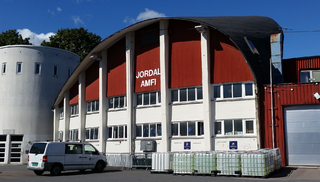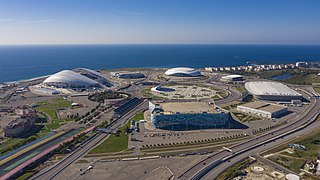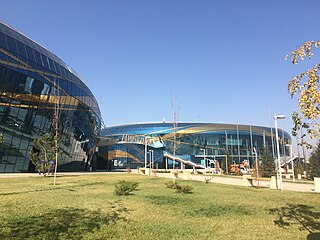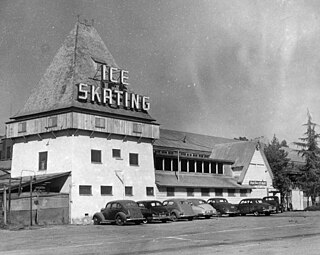
Sonja Henie was a Norwegian figure skater and film star. She was a three-time Olympic champion in women's singles, a ten-time World champion (1927–1936) and a six-time European champion (1931–1936). Henie won more Olympic and World titles than any other ladies' figure skater. She is one of only two skaters to defend a ladies' singles Olympic title, the other being Katarina Witt, and her six European titles have only been matched by Witt.
The Philadelphia Arena was an auditorium used mainly for sporting events located at 46th and Market Streets in West Philadelphia.

Berlin Sportpalast was a multi-purpose indoor arena located in the Schöneberg section of Berlin, Germany. Depending on the type of event and seating configuration, the Sportpalast could hold up to 14,000 people and was for a time the biggest meeting hall in Berlin. The Sportpalast is most known for speeches and rallies that took place during Nazi Germany, particularly Propaganda Minister Joseph Goebbels's 1943 "Total War" speech.

The Duquesne Gardens was the main sports arena located in Pittsburgh, Pennsylvania, during the first half of the 20th century. Built in 1890, the building originally served as a trolley barn, before becoming a multi-purpose arena. The Gardens opened three years after a fire destroyed the city's prior sports arena, the Schenley Park Casino, in 1896. Over the years, the Gardens was the home arena of several of Pittsburgh's historic sports teams, such as ice hockey's Pittsburgh Pirates and Pittsburgh Hornets. The Western Pennsylvania Hockey League, which was the first ice hockey league to openly hire and trade players, played all of its games at the Gardens. The arena was also the first hockey rink to ever use glass above the dasher boards. Developed locally by the Pittsburgh Plate Glass Company, Herculite glass was first tested in Pittsburgh. Most rinks were using wire mesh before the shatterproof glass was invented. Finally, the Pittsburgh Ironmen, a charter member of the Basketball Association of America, played at the Gardens from 1946 to 1947.

Jordal Amfi was an indoor ice hockey rink in Oslo, Norway, the first bearing that name. The venue opened in 1951 to host the 1952 Winter Olympics. Jordal was also the site of the 1958 and the 1999 IIHF World Championship. It would in the following decades also serve several boxing matches and concerts.
Michael J.R. Kirby was a Canadian figure skater who competed in men's singles, and was also an actor. Later was an ice rink owner and skating coach.

Planet Ice Arena Milton Keynes is a 2,800-capacity multi-purpose ice rink/hockey rink located in Milton Keynes, England, as part of the Leisure Plaza complex.

The St. Nicholas Rink, also called the St. Nicholas Arena, was an indoor ice rink, and later a boxing arena in New York City from 1896 until 1962. The rink was one of the earliest indoor ice rinks made of mechanically frozen ice in North America, enabling a longer season for skating sports. It was demolished in the 1980s.

Wilhelm Henie was a Norwegian sportsman and furrier. He was track cycling World Champion in 1894, and competed at the European Speed Skating Championships in 1896. Henie was coach and manager for his daughter Sonja, who became a famous international figure skating champion and later a major American film star.

Gloria Nord, born Gloria Nordskog, was an American roller skater, ice skater and pin-up girl who became known as "Sonja Henie on wheels," and "the Sonja Henie of the roller rinks." Nord was reportedly "adored by millions in the 1940s and 1950s for her balletic finesse and theatrical flamboyance."

Sochi Olympic Park is an Olympic Park in Sochi, Russia. It situated in the urban-type settlement of Sirius in Imeretinsky Valley, on the coast of the Black Sea. The Olympic Park houses the main Olympic Stadium used for the Games' ceremonies, and the venues that were used for indoor sports such as hockey, figure skating, curling, and speed skating. It also houses training facilities, the Olympic Village, the international broadcasting centre, and other amenities. The park was designed so that all of the venues would be accessible within walking distance of each other. The venues are situated around a water basin containing a fountain known as "The Waters of the Olympic Park".

Patinoire Axel Vega, commonly known as Patinoire de Mériadeck after the eponymous Mériadeck quarter, is a multi-purpose arena located in Bordeaux, Gironde, France. Today primarily used as an ice rink, it is the home of professional ice hockey team Boxers de Bordeaux. Between 1981 and 2017, it doubled as the agglomeration's main concert venue, and hosted many artists of national and international stature.

Almaty Arena is a multi-purpose indoor arena located in Almaty, Kazakhstan which was opened on 18 September 2016 and seats 12,000 spectators for ice hockey. Apart from hosting ice hockey matches, the arena is venue for boxing, figure skating, basketball, concerts, and other events. It is one of the venues to host the 2017 Winter Universiade. The arena is located in the north of punched Ryskulov Avenue, to the west from Momyshuly street in the Alatau District.

The St. Moritz Ice Rink, built as the Wattle Path Palais de Danse in 1923 and then used as Efftee Studios from 1933, was an ice rink on The Esplanade, St. Kilda, Victoria, which operated between 1939–1981. Opened as St. Moritz Ice-skating Palais, as one of only two ice rinks in Melbourne in the 40s and 50s, it played a central role to the sport of ice hockey in Australia. Closed in 1982, it soon suffered a major fire and was then demolished, an event later seen as a major blow to the heritage of St Kilda.
The Palais omnisports Marseille Grand-Est, abbreviated as POMGE, is a multi-purpose arena primarily used as an ice rink, located in Marseille, Bouches-du-Rhône, France. It is the home venue for ice hockey team Spartiates de Marseille. The complex also houses a skate park which, at the time of its opening, was billed as the largest such indoor installation in Europe.
It was inaugurated in 2009, and is popularly known as Patinoire de la Capelette after the Marseille quarter it sits in, la Capelette.
The 181st Street Ice Palace in Manhattan, New York was an indoor, artificial ice rink. The venue was used for a variety of ice-related activities but was primarily a figure skating and speed skating rink.
Piscine patinoire de Boulogne-Billancourt is an administrative ensemble consisting of two neighboring but physically separate sports venues located in Boulogne-Billancourt, Hauts-de-Seine, France, just west of Paris. The ice rink is home to the ice hockey section of multisports organization AC Boulogne-Billancourt, which was one of the sport's most prominent West European representatives in the late 1950s and early 1960s.
The Palais de Glace in Los Angeles, California was an indoor, artificial ice rink. The venue was the first artificial ice rink in Southern California and served the community until it was destroyed by fire in 1934.

The Tropical Ice Gardens in Los Angeles, California was an outdoor artificial ice rink. In its short life, the Ice Gardens served as home to several ice hockey teams as well Sonja Henie's ice show.













